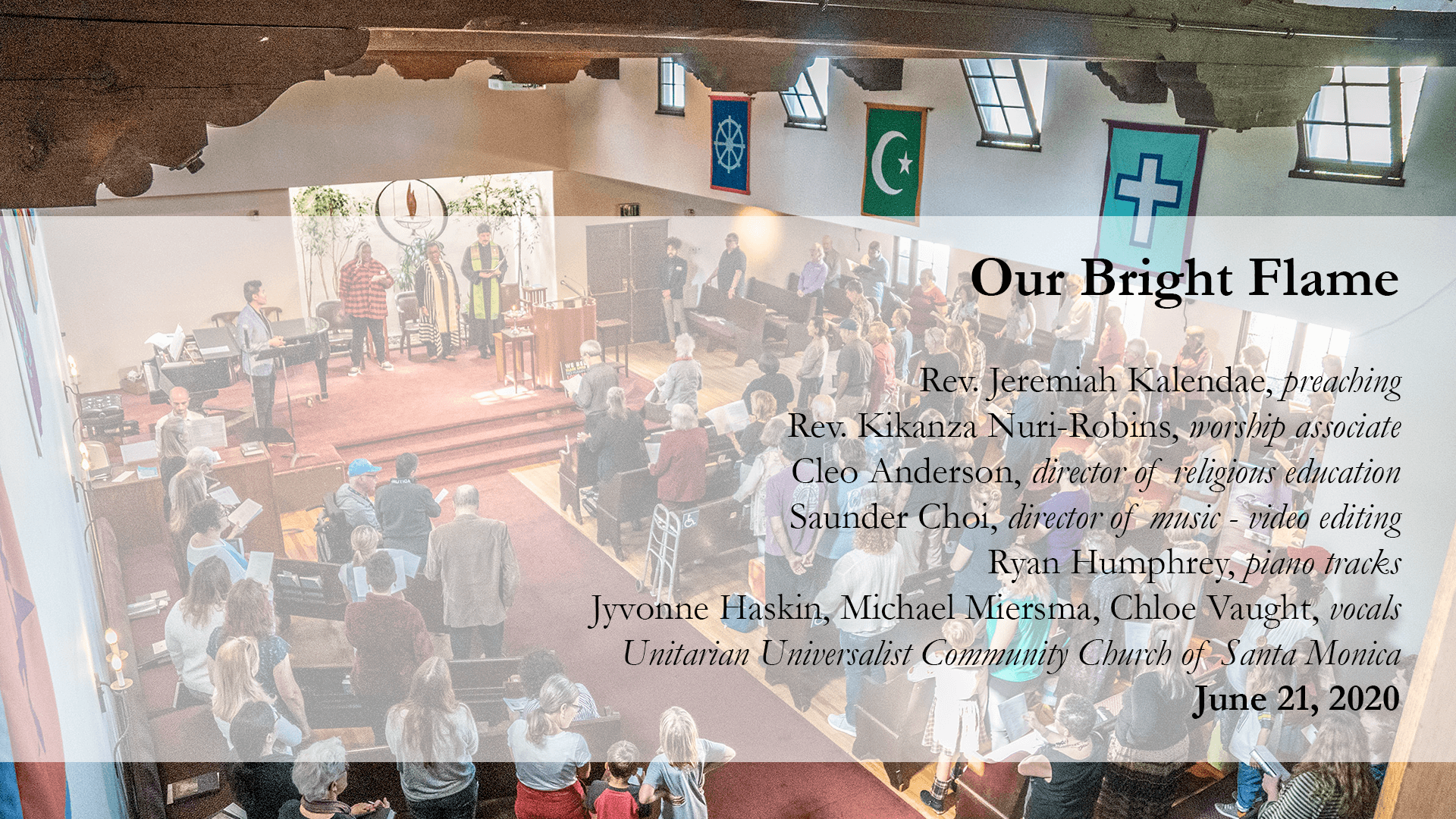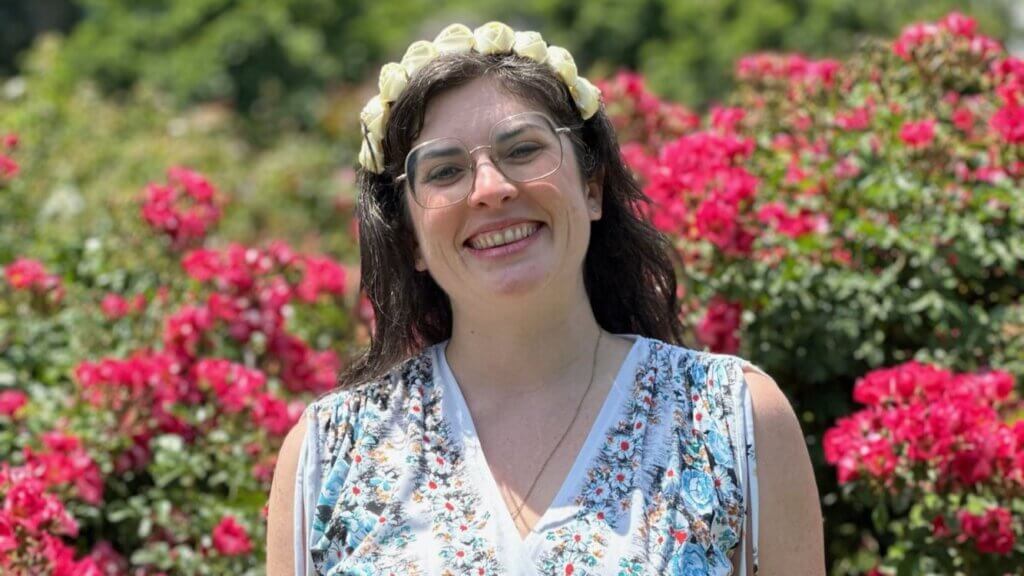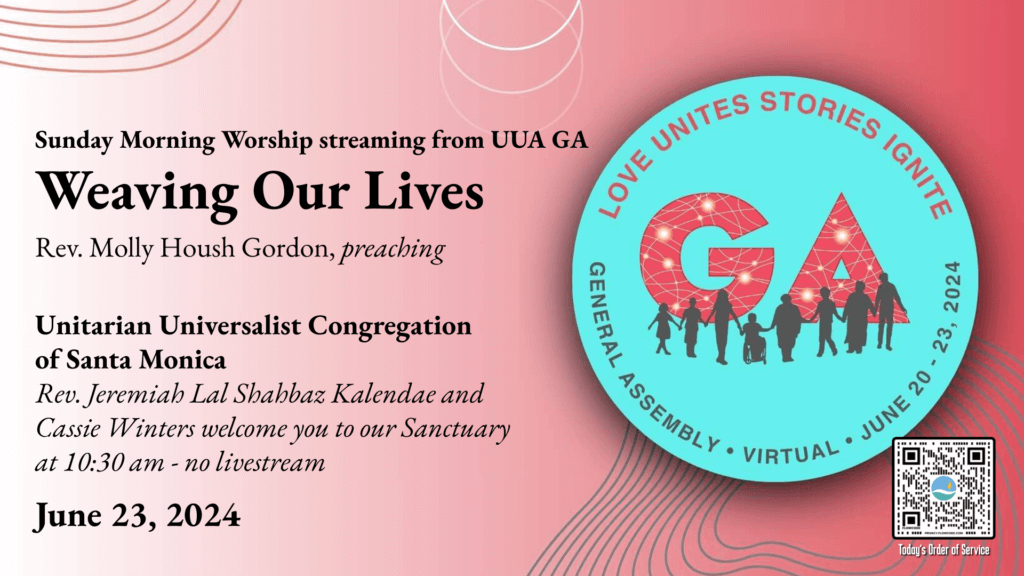(15-minute read, 2000+ words, get a cup of coffee or tea, and enjoy our story!)
When COVID-19 shut down our face-to-face church services and meetings in mid-March, a diverse team began building on skills learned in previous lives to create the high-quality productions streamed live on Facebook on Sunday mornings. The Rev. Jeremiah has observed that “we are learning to be videographers, editors, lighting and sound designers, producers, tech gurus, and intellectual property law experts all at once!”
(The intellectual property law reference concerned a traumatic event on Easter Sunday when our Facebook livestream was shut down by a copyright claim. The music clip targeted in the complaint was written and performed by our music director, Saunder Choi, using copyright-free background images, and did not violate any copyrights. The complaint had been lodged by an international music rights company using automatic scanning software looking for potential content infringement and has been fully withdrawn.)
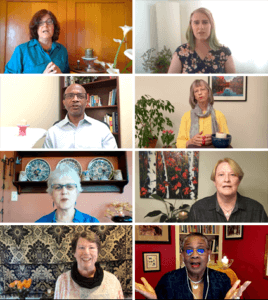 Each Sunday’s production begins weeks in advance with the Worship Associates and Rev. Jeremiah meeting to develop a concept and plan for the service (see the Join Our Worship Team article for an overview of their process). The needs for specific service elements emerge from these meetings. Current events change the process week-to-week, but typically, Saunder meets with the choir section leaders and pianist Ryan Humphrey on Sundays after the service to discuss the music to be recorded and produced for the following and future weeks.
Each Sunday’s production begins weeks in advance with the Worship Associates and Rev. Jeremiah meeting to develop a concept and plan for the service (see the Join Our Worship Team article for an overview of their process). The needs for specific service elements emerge from these meetings. Current events change the process week-to-week, but typically, Saunder meets with the choir section leaders and pianist Ryan Humphrey on Sundays after the service to discuss the music to be recorded and produced for the following and future weeks.
Saunder also meets with Rev. Jeremiah every Tuesday (they met on Thursdays before the church’s closure; the video production schedule requires more production time for everyone at the end of the week). According to Rev. Jeremiah, he and Saunder collaborate on the upcoming and future services, exploring options for the music to enhance “the overall concept, message, and flow/progression of the service.”
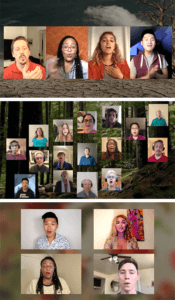 While this video does not fully reflect Saunder’s process because he uses much more advanced audio and video editing software, it helps to explain some of the steps he takes to produce the music sections. After the meeting with music staff, he decides on specific deadlines for when each deliverable is supposed to be done, including guide tracks, click tracks, and vocal stems from each of the singers.
While this video does not fully reflect Saunder’s process because he uses much more advanced audio and video editing software, it helps to explain some of the steps he takes to produce the music sections. After the meeting with music staff, he decides on specific deadlines for when each deliverable is supposed to be done, including guide tracks, click tracks, and vocal stems from each of the singers.
Using a Digital Audio Workstation (DAW) to compile all the material once it’s been uploaded to Dropbox by the musicians, he begins mixing the tracks. “Once a rough mix is achieved, I send it back to the singers so they have something to sing to while they record their individual videos. The videos and audio then get compiled into the final product that you see every Sunday!”
UUSM is extremely lucky that Saunder received a BA in Communications before moving from Manila to Boston to attend Berklee College of Music, where he also had a side gig as a video production assistant. Read more about our extremely talented music director at www.SaunderChoi.com.

By Thursday evening, all other recordings from the Worship Associate for the week, Director of Religious Exploration Cleo Anderson, and Rev. Jeremiah or whomever is preaching that Sunday, and new lyric and title slides prepared by Pam Teplitz, have been uploaded to Dropbox and Google Drive accounts so that Saunder can work his magic on Friday. Saunder’s production process takes nearly 20 hours each week.

Downloading and uploading the digital video to the Facebook streaming service we use and to youtube.com, and preparing it to go live on Sunday morning is accomplished by our webmaster, Elizabeth Fuller. On Saturday, she takes Saunder’s completed video from Dropbox, and uploads and schedules it for Facebook and YouTube. This “can take anywhere from an hour to three hours or more before a video is ready to view there, depending on the speed of our internet connection and the speed of the various sites involved, on any given day,” she explains. “So it’s worth doing at least 12 hours in advance of the service time, if not more, just to make sure there’s enough time to fix things if there’s any sort of glitch or problem, like when it turned out one of Saunder’s files was corrupted and he had to re-upload it to Dropbox before I could do anything with it. Best to discover such things as far in advance as possible.”
Liz also posts the Facebook Livestream on the uusm.org website and Pam adds it to the news.uusm.org newsletter site. Afterwards, the YouTube version is archived on both sites. Liz also isolates the music sections and posts them as individual music videos on our YouTube channel.
 Throughout the livestream, Liz, the Worship Associates, Rev. Jeremiah, Eileen McCormack, Lois Hutchinson, Pam, and many others help others on Facebook find the livestream, answer technical questions, moderate comments, and direct people to the YouTube version if they’re having trouble with the Facebook stream. For about a half hour afterwards, the same group helps people find the coffee hour on the private UUSantaMonica Group page and answer questions and posts.
Throughout the livestream, Liz, the Worship Associates, Rev. Jeremiah, Eileen McCormack, Lois Hutchinson, Pam, and many others help others on Facebook find the livestream, answer technical questions, moderate comments, and direct people to the YouTube version if they’re having trouble with the Facebook stream. For about a half hour afterwards, the same group helps people find the coffee hour on the private UUSantaMonica Group page and answer questions and posts.
For Liz, “the whole process brings back a LOT of memories of when I worked in a TV control room, right after college. It’s very much about being in the moment and being very aware of a lot of things happening at once. And even on the best of days, something always goes wrong. But if you give yourself enough time to deal with unexpected technical issues, you can usually solve them before they become obvious to viewers.”
Rev. Jeremiah concludes, “I develop the spiritual concept of each worship service and then our various leaders and professional staff bring their gifts to help bring the concept to life. It is a very organic process and I appreciate the dynamism that is the result of the convergence of so much talent and creativity. I do not try to dictate the process but rather I try to hold the space for everyone’s creativity to unfold. This brings a certain freshness to the services and I am always delighted to experience what’s been created come Sunday morning.”
Following are personal reflections on the process by our worship leaders.
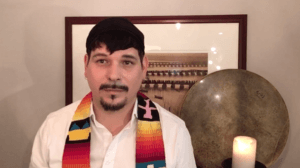 Rev. Jeremiah Kalendae:
Rev. Jeremiah Kalendae:
Worship takes more time than it did before we went online. Typically, I would have to invest significant time reading, researching, contemplating, and writing, and then I would present the result from that spiritual process on Sunday mornings. Now we have had to include additional time in the week to setup the staging for the video production (i.e., rearranging furniture, adjusting the lighting, doing sound checks, ensuring no background noises, putting my kitten in the other room, etc.) and then have to record multiple times to get as few mistakes as possible in the final videos. I realized they’re not going to be perfect and accepted that at the onset and I think people appreciate it. It makes it more real even if creating worship now includes incorporating multiple processes and technologies from Hollywood. So much has been added to my weekly routine in terms of now having to “produce” worship outside of Sunday morning. Once each team produces their videos, they then go through the final editing process and are uploaded for the service.
Thankfully, I spent some time in the theater growing up and in college, so those experiences helped me think through some of the technical aspects of creating worship online like lighting and sound and the setting. We also have some collegial groups that have been sharing best practices, but most are learning on the fly and we’ve been experimenting as we go. Most of these new technologies and formats aren’t things you study in theological school or practice in the field. Ministers, however, are usually highly educated and experienced when it comes to having to adapt to new realities and integrating new information. So there’s been a lot of new research, study, and experimentation that have been brought into the production process.
Preaching to a camera is very different from offering a sermon in the context of a worship service. I always imagine the sermon arising within the atmosphere of worship. There is something sacred about community gathering together, the singing of hymns, hearing the beautiful voices of the members of our choir, listening to the inspiring words of our Worship Associates, reciting the words of our covenant, and so many other elements of our liturgy before beginning to preach. I miss all of that happening in our sanctuary, but we are recreating some of that experience with our Sunday morning services. Knowing that what we are doing is protecting the vulnerable and demonstrating love in a very real way makes it all worthwhile.
I do think about everyone who is gathering for worship and also that our worship is much more public than it was before, so it is reaching more people and diverse audiences in the world. I always pray that I be given the wisdom and the love and the words that will be most helpful to the people I serve in ministry.
I have tried to create specifically pastoral services since the beginning of the pandemic. We’ve had to balance acknowledging the grim realities of the pandemic and the stress people have been under and the anxieties they’ve been experiencing while also putting some boundaries around those realities and not allowing them to become all-consuming. Worship is also a process of religious education and exploration, so I didn’t want to lose those dimensions either as this crisis was unfolding. It did mean I shortened my messages and tried not to go too deep or get too complex with the theologies and philosophies of the messages because so many were already at or beyond their bandwidths given everything else they we dealing with in life. I felt it was important that worship provide comfort and inspiration in these very challenging times. Now that we’ve reach a new normal and we’ve learned how to be effective with our production processes, I am beginning to bring a new spiritual depth to the worship services.
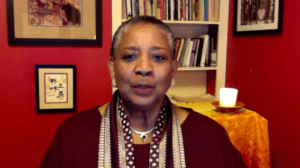 Rev. Kikanza Nuri-Robins, Worship Associate Chairperson:
Rev. Kikanza Nuri-Robins, Worship Associate Chairperson:
I call UUSM my home and I serve in a number of churches in Greater Los Angeles. In that capacity I have been able to see a number of approaches to online worship. While I am very comfortable in the pulpit and love worship planning, going online provided me with several unwanted learning experiences.
I have had to learn to make a movie, save the movie and send it. I have had to learn to communicate across several platforms — Zoom, Teams, GoToMeeting, and Facebook. The greatest challenge for me has been translating my charm and humor into something that works on these platforms. As a speaker I rely on the energy in the room — with these virtual pulpits the only energy in the room is mine. So I have had to use more of my rational brain and to rely more on Grace.
The greatest advantage for me is a large monitor that is on my desk. I am able to sit comfortably, scroll imperceptibly through my text, and create what l hope looks like eye contact. I have had to make my hand gestures smaller, and rather than pretending I am talking to a room full of people, I talk to the one person who is on the other side of the camera — you.
I think it is working. Each week I am a little more comfortable and tremendously grateful for all of the people who work backstage to make the online worship services possible. Our service is less interactive than perhaps a Zoom service, but our production values are the highest I have seen.
Moreover, one of the great advantages of these virtual services is that they are recorded and can be played over and over. People who are not in the area can participate in the service. So my friends from Palos Verdes and Long Beach can join us in worship. And our friends in Oregon and New York can join us. And the friends of our friends, people who might have considered joining us but haven’t until now, are right there on Sunday morning.
The other great advantage of our online worship is that we, who produce the services, are developing skills, and acquiring equipment, that also will enhance the production values of our services when we are once again, altogether, in the same room.

